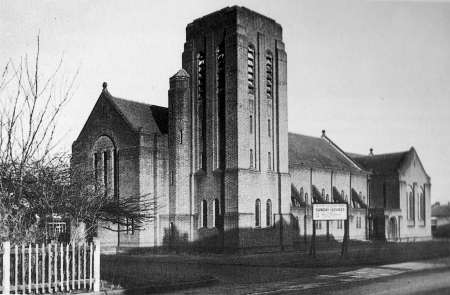Church of the Holy Angels, Moorfield Road, Claremont
In the early twentieth century, Ethelred, Isabel and Monica three spinster sisters of Sir Arthur Percival Heywood, 3rd Baronet, who were living in the family home, Claremont (a house now demolished), found themselves at odds with the incumbent of St John’s Church, Pendlebury. As a result, Sir Arthur, to provide “a comfort to his sisters,” donated £1,000 and a large piece of land on the Claremont estate for a new church, dedicated on 10 November 1915, its dedication being a thanksgiving for the reported intervention of angels at the Battle of Mons. In 1925 Bradshaw Gass and Hope were commissioned to design the permanent Church of the Holy Angels, on Moorfield Road, Pendleton, consecrated on 7 January 1928. It is suggested that the church was designed by relatively junior members of staff at the Bolton practice. By the mid-1990s, the building was found to be unsafe because the mortar had degraded to such an extent that it was little more than sand. As a consequence, the building was demolished in 1997.
NEW PENDLETON CHURCH – The Bishop of Hulme (Dr J C Hill) on Saturday laid the foundation stone of the new Church of the Holy Angels, Claremont, Pendleton. The estimated cost of the building is between £14,000 and £15,000, and something like £10,500 of this has been raised. There will be seating for between five and six hundred persons. The Claremont estate has been developed on residential lines, and a new parish has been created. [Manchester Guardian 28 June 1926 page 11]
CONSECRATION OF A PENDLETON CHURCH – The new Church of the Holy Angels at Claremont, Pendleton was consecrated on Saturday afternoon by Dr Hill, Bishop of Hulme. … A fund for the building of the new church was started about twelve years ago. The cost of the fabric will be about £15,000 with £1,900 additional for the organ and more than 75% has been raised. The parish has been carved out of three parishes of St Anne, Brindleheath, St James’s, Hope and St John’s Pendlebury. The site of the church is between Acresfield Road and Moorfield Road, and the plot is large enough to accommodate a vicarage and parish hall, which will be proceeded with as soon as possible. Architecturally the church is described as a modern interpretation of the work of the Norman period, and is designed with a breadth of treatment suited to the brick material used throughout the building. Runcorn stone has been used in the construction of the pulpit, lectern and chancel wall, which are the gifts of the freemasons of the district. In the style of the pulpit the Anglo-Norman simplicity of the other features has been followed, the upper part being enriched by sunk panels enclosing carved Norman arches carried on small attached columns with cubic capitals. On the centre panel is a cross motif within a circumscribing circle, and on the splayed face of the base directly beneath is carved a Masonic emblem. Some of the windows in the chancel contain panels of stained glass figures from Doveleys Hall, Derbyshire, presented by Sir Percival Heywood, Bart. [Manchester Guardian 9 January 1928 page 11]
Reference Manchester Guardian 10 November 1925 page 20 - “breaking the ground”
Reference Manchester Guardian 8 January 1926 page 11 – creation of new parish
Reference Manchester Guardian 28 June 1926 page 11 – foundation stone
Reference Salford City Reporter 3 July 1926 Page 4
Reference Dobbs Like a Mighty Tortoise page227-229 with illustration
Reference David H. Kennett British Brick Society Information 92, 2003 page 15}
Reference ICBS 11660 Folios 68ff Minutes: Volume 33 pages 288, 304, 338 Ground plan (after work); Gallery (after work)
